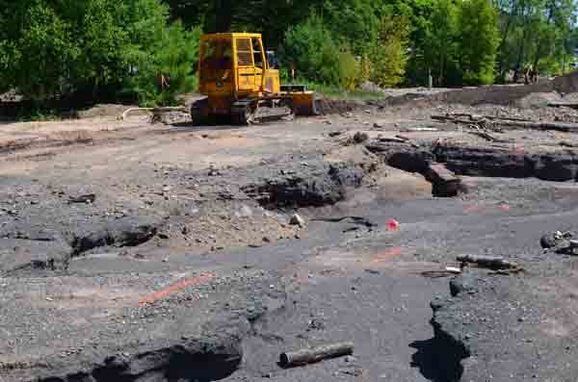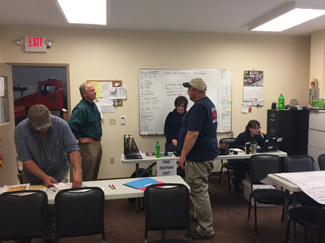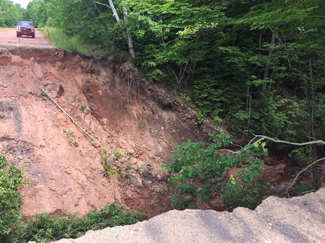
By TIMOTHY WEBB
Michigan Department of Natural Resources
 Most people
in Michigan know the Department of Natural Resources plays a critical
role in keeping people, homes, forests, fields and other resources protected
when wildfires take off.
Throughout
the state, DNR staff members stand trained and ready
for dispatchers to send them off to the next fire. What most people don’t know
is how that same training prepares those firefighters for all kinds of other
disasters.
The DNR Forest
Resources Division supports four incident management teams, two each in the
Upper and Lower peninsulas.
While
their primary job is coordinating response to large fires, the teams’ training
under the National Incident Management System also prepares them to assist in
just about any other catastrophe.
Many team
members attend workshops specifically geared to “all hazard” response. There,
they run through simulations of tornadoes, floods and many other emergency situations.
Small
incidents requiring only a few people, who are involved for a short length of
time, don’t really need oversight from an incident management team. But when
lots of people and multiple agencies get involved for more than a day or two, an
incident management team can step in to coordinate the effort.
“Incident
management teams help bring organization to chaos,” said Jim Fisher, the DNR’s
fire section manager. “A team
can expand or contract to fit the situation at hand. The more complex the
incident, the bigger the team.”
|
 Team members on a large fire or other
incident in Michigan might be responsible for requesting and checking in
responders and equipment, developing strategies to attack the problem,
coordinating tasks and communications among responding agencies, providing
food, supplies and lodging for staff, producing incident maps and weather
reports, collecting information for the media, and so on.
DNR teams are managed by the Forest Resources
Division but include members from other DNR divisions who help with communications,
finances and logistics.
In the early morning hours of Sunday, June
17, torrential rains sent emergency responders in Houghton County into action.
The National Weather Service reported 7 inches of rain fell over nine hours.
The rainfall, coupled with the steep
topography in and around Houghton and Hancock, resulted in dozens and dozens of
roads, homes and businesses damaged or destroyed by flash floods, landslides
and cave-ins.
According to plan, Houghton County’s
emergency operations center mobilized its own incident management team.
At the same time, the storm-ravaged area
recreational trails and boat ramps, elicited a response from DNR’s Parks and
Recreation Division.
Jeff Kakuk, western Upper Peninsula trails specialist
for the DNR, started checking local trails later that same day. He quickly
determined the task before him was enormous, well beyond what could be handled
with local staff.
|
 DNR officials soon decided an incident
management team could help Kakuk and others start wrapping their arms around
this overwhelming situation.
By Wednesday morning, team members began
arriving from across the state. The Quincy-Franklin-Hancock Townships Volunteer
Fire Department offered its fire hall for use as DNR’s
incident command post.
Brian Mensch,
DNR fire supervisor at nearby Baraga, stepped in as incident commander to lead
the team.
“Our first job was
to size up the damage to the local DNR trails and close off the damaged
portions of the trail system as quickly as possible for public safety,” Mensch
said.
During the next several days, DNR ground
crews documented 150 washouts on about 60 miles of trails.
After putting up fencing and signs to close
off critical trail access points, they started the lengthy process of repairing
washouts and regrading eroded trail surfaces. Staff also dug out plugged
culverts and delivered and spread gravel on storm-damaged trails.
Just 12 days after the rains, the DNR Forest
Resources and Parks and Recreation divisions’ staffers had reopened more than
40 miles of trails and two boating access sites in the county, which needed
only minor repairs.
That’s about where the incident management
team’s work ended. It had taken care of immediate public safety concerns, assessed
the storm damage and got ground crews rolling on initial trail repairs.
|
 Team members had engaged the Michigan Department
of Environmental Quality and a private engineering firm to help plan repairs of
the major trail washouts. Cost estimates had been delivered to the Federal
Emergency Management Agency for potential federal disaster funding.
“At that point, the team handed things back
over to Parks and Recreation Division staff to oversee and implement the long
recovery process, with the goal of restoring the recreation infrastructure so
important to the Copper Country economy,” Kakuk said.
Incident management team members returned to
their home stations after spending just over a week at the incident.
It will take quite some time before things
are back to normal in Houghton County, but the DNR’s incident management team
members are back to their own normal – waiting for the next dispatch to a
wildfire or whatever else nature throws in their direction.
Check out
previous Showcasing the DNR stories in our archive at michigan.gov/dnrstories. To subscribe
to upcoming Showcasing articles sign-up for free email delivery at michigan.gov/dnr.
|
/Note to editors: Media contact: John Pepin, 906-226-1352. Accompanying photos are available below for download. Caption information follows. Credit Michigan Department of Natural Resources, unless otherwise noted.
Crew: A Michigan Department
of Natural Resources trail crew from Grayling works on the Lake Linden Trail just
outside Hancock.
Damage: Flooding damage to the
Lily Pond boating access site in Houghton County is shown.
Debris: Michigan conservation
officers inspect debris washed into the Portage Canal in Houghton County after the
June 17 flooding event.
Repair: A heavy equipment
operator works on repairs to a trail near Hancock in Houghton County.
Slice: A section of the Lake
Linden Trail sliced through by flood waters is shown.
Survey: Michigan Department of
Natural Resources Director Keith Creagh (right) and Michigan Department of
Transportation Director Kirk Steudle surveyed parts of Houghton County in June
to see trails, road and boating access site flooding damage first-hand.
Talks: Michigan Department of
Natural Resources Director Keith Creagh (second from left) talks with staff
from the DNR’s incident command post set up in Hancock.
Washout: One of the significant
washouts along the Lake Linden Trail in Houghton County is shown.
Water: A bulldozer works to
repair a section of trail where damage was caused in June in Houghton County./
|